I can’t believe I have to write this down right now, but my dear friends, medieval people bathed regularly.
Yes. I assure you. I am very serious. It is true.
In fact, medieval people loved a bath and can in many ways be considered a bathing culture, much in the way that say, Japan is now. Medieval people also very much valued being clean generally in an almost religious way.
This is not to say that getting clean was as easy for medieval people as it is for us now. But medieval people were very clever and had ways of getting around that.
So, say you are an average-ass medieval person. That means you are a peasant, because 85% of the population or so were peasants. This meant that you were working very hard doing manual labour in a field. How would you stay clean? Well you would probably wash daily at home. This usually involved filling an ewer with water, heating it and then poring it into a larger basin which allowed for ease of scrubbing, like so:

You might also have a special wooden bathing tub that would be brought near the fire, as and when needed, and filled for a more luxurious bath on occasion, like so:
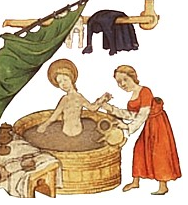
So that’s how you got around the hot water problem, just a lot of work.
Say that you couldn’t or didn’t have time to heat up water though, what then? Well people would just bathe in a local water source, like so:
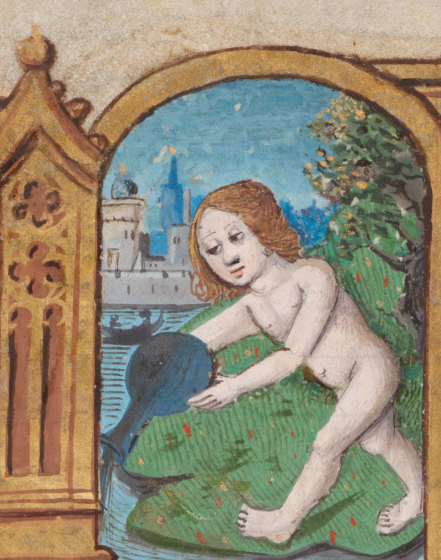
So, fine, regular people figured out how to get wet, right? Well, the other thing that is important to note here (and I can’t believe I am saying this), when washing at home medieval people used soap. Yes. I am serious. They did.
In fact soap is a motherfucking medieval invention. Yes. It is. The Romans – whomst I don’t see a bunch of basics going around accusing of being filthy – did not, in fact have soap, in contrast. They usually washed using oil. Medieval people? Oh you better believe that they had soap.
It was first introduced from the East, like most good stuff was at the time, but it took off rather quickly. Your peasant ass would likely have been making soap at home, and books of secrets often included various recipes for soap, all of which can still be made today. The general ingredients were usually tallow, mutton or beef fat, some type of wood ash or another, potash, and soda.
However, soap could also be purchased. As early as the seventh century soap makers guilds began to spring up , trading it as a high value commodity. If you were fancy enough to be buying soap you could also get the good imported stuff initially from Aleppo, which was traded heavily and involved laurel oil rather than animal fat. After importing rather a lot of this to Castille, in the twelfth century the denizens there got to thinking that they could probably create a similar product using the local olive oil. Voila! Castille soap was born and also became a popular trade good.

Even if you couldn’t get the good fancy soap, many people would scent the water that they bathed in, often with thyme or sage. People often used herbs not just for washing, but in deodorant as well. Yes. They had deodorant. It was often made of bay leaves, hyssop or sage. In fact, one of the more popular medieval deodorant recipes came from Dioscorides, a Greek physician active in the first century AD. His De Materia Medica was super popular throughout the medieval period and advised readers on how to make a deodorant using salvia and sage.
Medieval people also regularly washed both their hands and faces both before and after meals when in between baths because – stay with me here – they knew that dirt and grime could be hazardous to their health if ingested. Yes. They did. They really really did. In fact, the whole washing after eating thing was an explicit health concern, because as medieval medical writers such as Magninius Mediolanesis noted,
If any of the waste products of third digestion are left under the skin that were not resolved by exercise and massage, these will be resolved by the bath.[1]
Our girl Hildegard of Bingen even had a recipe for face cleanser because apparently she was a skin-care bitch. She advises that,
one whose face has hard and rough skin, made harsh from the wind, should cook barley in water and, having strained that water through a cloth, should bathe his face gently with the moderately warm water. The skin will become soft and smooth, and will have a beautiful color.[2]
So yes, medieval people, even regular old peasants were pretty clean types of people. In fact, they were so clean that for them bathing constituted a leisure activity. So the average person would likely wash daily at home, but once a week or so they would treat themselves to a bath at the communal bath house. That is where the party was at.
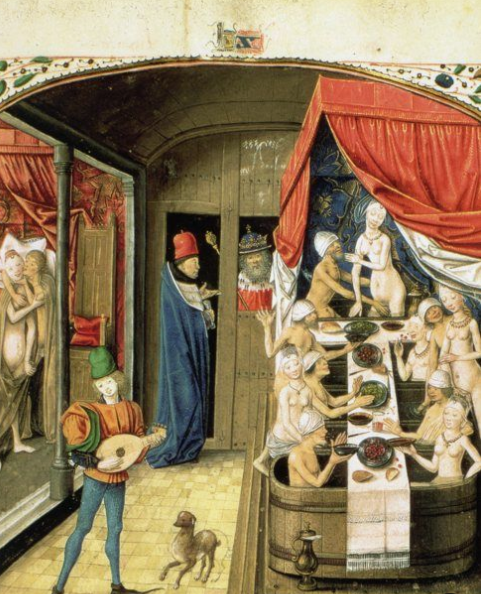
Medieval bathhouses were big fucking business. In Paris Bathhouse Keepers constituted a guild and there were a specific set of rules that they had to follow in order to make sure they remained in good standing. [3] To whit:
Whoever wishes to be a bathhouse-keeper in the city of Paris may freely do so, provided he works according to the usage and customs of the trade, made by agreement of the commune, as follow.
- Be it known that no man or woman may cry or have cried their baths until it is day, because of the dangers which can threaten those who rise at the cry to go to the baths.
- No man or woman of the aforesaid trade may maintain in their houses or baths either prostitutes of the day or night, or lepers, or vagabonds, or other infamous people of the night.
- No man or woman may heat up their baths on Sunday, or on a feast day which the commune of the city keeps.
And every person should pay, for a steam-bath, two deniers; and if he bathes, he should pay four deniers.
And because at some times wood and coal are more expensive than at others, if anyone suffers, a suitable price shall be set by the provost of Paris, through the discussion of the good people of the aforesaid trade, according to the situation of the times.
The male and female bathhouse-keepers have sworn and promised before us to uphold these things firmly and consistently, and not to go against them.- Anyone who infringes any of the above regulations of the aforesaid trade must make amends with ten Parisian sous, of which six go to the king, and the other four go to the masters who oversee the trade, for their pains.
- The aforesaid trade shall have three good men of the trade, elected by us unanimously or by a majority, who shall swear before the provost of Paris or his representative that they will oversee the trade well and truly, and that they will make known to the provost of Paris or his representative all the infringements that they know of or discover, and the provost shall remove and change them as often as he wishes.
You, my gentle readers may have picked up on something here, and that is that our girls the sex workers be showing right TF up in the public baths. This meant that whether or not you admitted them made the difference between whether you were keeping a bathhouse or a brothel. Here in London, of course the Stews in Southwark were essentially brothels where you could also have a bath (and were largely owned by the Bishop of Winchester (as you do). Having said that, there were plenty of people who went to bathhouses just to go to bathhouses and by 1292 in Paris, there were at least 26 running that could give you just a bath.[4] Medieval people related to this very much as we do having a spa day, and medieval bathhouses often included steam baths along with big wooden tubs where you could sit down and enjoy a meal. In order to stand out from the crowd, the Parisian bathhouses would even employ criers to advertise themselves.[5]
And, I cannot stress this enough, this was just for regular ass people. Rich people? Oh, you better believe they were bathing, and often had dedicated rooms for washing unlike the poors. They also might go places simply to bathe, like Bath in England, or the thermal baths in Pozzuli in Campania, which was so famous it had a whole ass poem, De balneis Puteolanis written about it. They could also afford that nice soap and perfume and all that good stuff. In fact they were so into poncey baths that most medieval knighthood ceremonies involved having a scented bath.
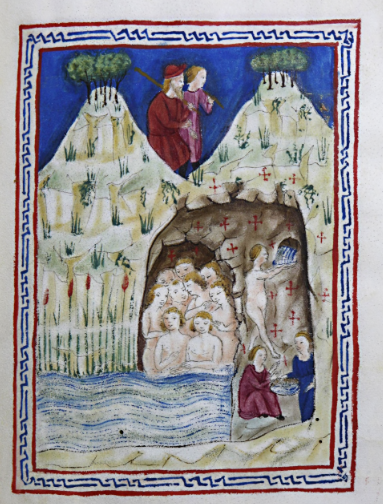
So OK, clearly, fucking clearly medieval people bathed and were clean and into it. So why am I telling you all of this? Well the idea that medieval people didn’t bathe is a persistent myth that some basics on twitter will come at me with at least once a week. Why is that?
Well part of it is a modern misunderstanding of the idea of bathing. It’s true that we have medieval sources which warn against “excessive” bathing. But here’s the thing, that wasn’t really about being clean, it was about hanging out naked in bathhouses with the opposite sex. They didn’t want you to not be clean, they wanted you to not be going down the bath house and getting your fuck on.
And yeah, some holy people didn’t bathe, notably saints who would forego bathing themselves but bathe sick or poor people.[6] But if you bring that up you are missing the point. Medieval people thought that bathing and being clean was really nice, so giving it up and living with your stank was a sign that you had given up on the corporeal world and only thought of heaven. It was holy because it was uncomfortable, like wearing a hair shirt, or eating vegan, and hitting your chest with rocks and sitting in the desert trying not to wank. You know, standard saint stuff. It is mentioned because it is uncommon and uncomfortable.
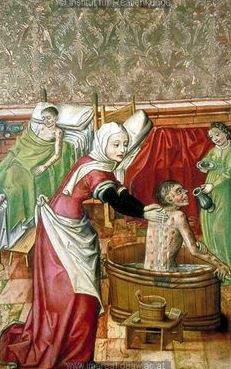
These things, while they make sense in context are often taken by people who have never learned a damn thing about the middle ages and read in the worst possible light. If you intrinsically believe (and it is a belief) that the medieval period is the Dark Ages, and very bad, then you read stuff like this and just assume people are gross and dirty, even if there’s no real evidence of that.
You know what else helps? Well, in the modern period sometimes people were gross. In both the sixteenth and eighteenth centuries, there were times when some doctors claimed that bathing was harmful. This was often linked to the idea that bathing with warm water would open the pores and allow contagion in. And here’s the thing about that – a lot of people just don’t know what the medieval period is, but they are pretty sure it is when stuff was gross. So if they hear about doctors telling you not to bathe they are like, “LOL medieval people were gross”, even if that is going down smack bang in the modern period.
Now on the one hand we can see this as a historical quibble. After all it’s not like I don’t have a history of getting big mad about someone incorrectly relating to the medieval period. But here’s the thing, allowing myths like this to perpetuate allows us to keep upholding harmful ideas about the medieval period that furthers our colonialist ideas about history, and simultaneously allows us to gloss over all the harmful and gross stuff that we as modern people do. If we always blame medieval people for everything difficult it allows us to deny their humanity and write off a thousand years of thinking and culture that still influences us now.
So, like, could you not?
[1] Quoted in, Fabiola I.W.M. Van Dam, “Permeable Boundaries: Bodies, Bathing, and Fluxes”, in, Medicine and Space: Body, Surroundings and Borders in Antiquity and the Middle Ages,(Brill, 2011), p. 125.
[2] Hildegard von Bingen’s Physica: The Complete Translation of her Classic Work on Heath and Healing, IV Barley.
[3] Etienne de Boileu, Le Livre des Métiers, in, Emilie Amt, Women’s Lives in Medieval Europe: A Sourcebook, (London and New York: Routledge, 1993) p. 162.
[4] Quoted in, Fabiola I.W.M. Van Dam, “Permeable Boundaries: Bodies, Bathing, and Fluxes”, in, Medicine and Space: Body, Surroundings and Borders in Antiquity and the Middle Ages (Brill, 2011), p. 125
[4] Jean Riolan, Curieuses recherches sur les escholes en médecine de Paris et de Montpellier, nécessaires d’estres sceuës pour la consevation de la vie, par un ancien docteur en médecine de la faculté de Paris(Gaspar Meturas, 1651), p. 219.
[5] Georges Vigarello, Concepts of Cleanliness: Changing Attitudes in France Since the Middle Ages, (Cambridge University Press, 1752) p. 21-22.
[6] Katherine Ashenburg, Clean: An Unsanitised History of Washing (Farrar, Straus and Giroux, 2008), p. 62.
If you enjoyed this, please consider contributing to my patreon. If not, that is chill too!
For more on myths about the medieval period and ignorance, see:
Plague Police roundup, or, I am tired, and you people give me no peace
How to win friends and influence people in medieval Europe on History Hit
If you are going to talk about the Dark Ages, you had better be right
JFC, calm down about the medieval Church
On Medical Milestones, Being Racist, and Textbooks, Part I
On Medical Milestones, The Myth of Progress and Being Racist, Part II
On medieval healthcare and American barbarism
On colonialism, imperialism, and ignoring medieval history
“I wasn’t taught medieval history so it is not important” is not a real argument, but ok
There’s no such thing as the ‘Dark Ages’, but OK
On the Concept of the Renaissance and Outkast’s Hey Ya
FUCK YEAH Genghis Khan – an emergency pubcast
On why the misuse of the word ‘medieval’ is a bad thing


I feel the need for a scented bath coming on.
LikeLike
Your enthusiasm for this topic is as contagious as the bubonic plague. An enjoyable read.
LikeLiked by 1 person
Good post. One quibble: The Romans did, in fact, know about soap, which they called “sapo”. This is a Celtic loan in latin, which shows from where they got it. Soap, as we know it, appears not to be an Asian invention, but from Central or Northern Europe, and reached the Greek and Roman world through trading hubs like Massilia (Marseilles).
LikeLike
Sapo is originally recorded largely as a pomade for hair in Pliny the Elder and is a loan word from Germanic. A lye based ball that was imported from Germanic tribes becomes more common from 2 AD, but is largely seen as a barbaric pretension. Large scale soap making and widespread recipes are not common until the medieval period. Thanks for playing.
LikeLike
I enjoy very much using Aleppo soap now a days
LikeLike
Source for unattributed image is “The Hague, KB, 76 F 21 fol. 15r Mary in bath Fol. 15r miniature,” cited by this site:
https://gardensbefore1800.blogspot.com/2017/08/bathing-in-gardens-countryside_2.html?m=1
LikeLike
Amazing! Thanks so much I really appreciate this.
LikeLike
thanks!
LikeLike
It’s amazing how clean one can get with a jug of hot water and a basin, washing one part of you at a time and then wrapping it up again. And my northern European hair likes to be washed about once a week, and it adores a rosemary infusion rather than shampoo. Thanks for trying to bust some of the myths.
LikeLike
My great-aunt used to make soap out of lye & ashes from the fireplace in a huge cauldron in her back yard! She used to let me stir the mixture! She was so much fun! Now I realize how much I learned from her without even knowing I was being taught.
LikeLiked by 1 person
That is so cool! What a nice experience!
LikeLike
Reblogged this on silverapplequeen and commented:
A wonderful blog I just discovered. If you’re into history like I am, you’ll give this a read!
LikeLike
I always thought they must have washed more than they were given credit for – they were human after all and most of us like feeling clean.
LikeLike
And they brushed their teeth! These myths about the Middle Ages just kill me. Don’t even get me started on the whole chomping on turkey legs and spitting on the floor thing.
Great post!
LikeLike
Needed to compose you a very little word to thank you yet again regarding the nice suggestions you’ve contributed here
Ayurvedic Soap with Sandal and Kesar
LikeLike
Nope.
LikeLike